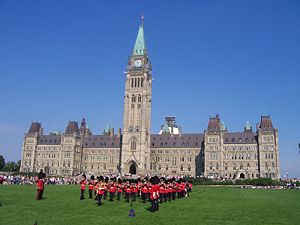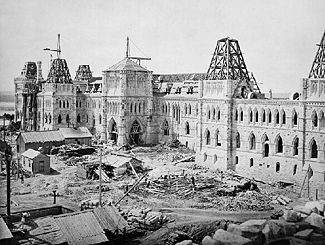Ottawa
Ottawa, Ontario, is the capital city of Canada, located at the confluence of the Ottawa, Rideau and Gatineau rivers in southeastern Ontario. The population as of 2006 was 812,129 [1].
History
The Ottawa region was home to the Algonquin people, who called the river the Kichi Sibi or Kichissippi, meaning "Great River". The first European settlement in the region was that of Philemon Wright who started a community on the Quebec side of the river in 1800. Wright discovered that transporting timber by river from the Ottawa Valley to Montreal was possible, and the area was soon booming based almost exclusively upon the timber trade. White Pine was common in the Ottawa Valley, and favoured by many European nations for its extremely straight and strong trunk. In the aftermath of the War of 1812 the British government assigned Colonel John By of the Royal Engineers to build the Rideau Canal between the Ottawa area and Kingston as a secure inland water route. A village, named Bytown, was established at the beginning of the canal. In 1855 this village was incorporated as a city and renamed Ottawa.
The British colonies which would eventually become Ontario and Quebec were from 1841 to 1867 known as Province of Canada. Ottawa was chosen as the capital of this united province in 1858, after the previous capital building in Montreal was burned by an angry mob.[2] In 1859 construction began on the government buildings on Barracks Hill. Fuller and Jones won the contract for a new parliament building with a bid of ₤75,000.In 1867, with the passing of the British North America Act, Ottawa became the capital of the federated provinces of Canada, and Barracks Hill became Parliament Hill.[3]
Before 1900 pulp and paper industries dominated the city's economy, making Ottawa a working-class town. As wood-based industries moved out, white collar public service, with some 30,000 employees by 1945, became dominant. Prime Minister Mackenzie King planned a worthy capital and, guided by the Gréber Plan of 1950, Ottawa was transformed into a modern city. Business travel and tourism became the second industry. Ottawa in 1950 undertook a large-scale annexation of the suburbs to increase the area of the city over four-fold, to control development and provide land for it.
High tech arrived in the 1960s. The National Research Council and the Defence Research Board were based in the city. Computing Devices was founded and Bell Northern Research (now Nortel) moved its operations to Ottawa. High-tech industry by 2000 was approaching in size the 70,000 employees of government.
In terms of religion and ethnicity, the city was long divided into Catholic/French and Protestant/English sectors; the school system continues to reflect that division. Immigration early in the 20th century created small Jewish, Italian, Asian, and German communities; they were joined after the 1945 by an Arabic-speaking community and more recently by East African and Vietnamese communities. By 2000 visible minorities represented about 15% of the population. English remains the dominant language at 65%; French, at 15% has slipped behind those who speak neither English nor French, at 19%.
Early urban planning in Ottawa took the form of a piecemeal architectural admixture. On paper there remains a series of largely unrealized proposals designed to promote an image symbolic of national identity. Successive federal and municipal agencies worked to various degrees of success to augment Ottawa's appearance and amenity. British planner Thomas Adams's departure from, and the subsequent demise of, the Federal Commission of Conservation in the early 1920s marked a low point in efforts to evolve comprehensive planning strategies. The career of Noulan Cauchon, first head of the Ottawa Town Planning Commission, aimed to keep the notion of planning alive in the city. Certain of his little-acknowledged proposals bear remarkable similarity to the pre-World War II planning efforts of Mackenzie King and Jacques Greber. Cauchon's legacy endures in proposals that appear to have been incorporated into federal planning activities during the postwar era.[4]
Government Buildings
The original Centre Block of the Parliament Buildings in Ottawa was itself destroyed by fire on February 3, 1916. The House of Commons and Senate were temporarily relocated to the recently constructed Victoria Memorial Museum, currently the Canadian Museum of Nature, located about 1 km south of Parliament Hill on Metcalfe Street. A new Centre Block was completed in 1922, the centrepiece of which is a dominant Gothic revival styled Peace Tower.
The Canadian Parliament is situated on Parliament Hill, a grouping Gothic Revival buildings, featuring Centre Block and the landmark Peace Tower.
The Art Deco-style Supreme Court of Canada Building was designed by Ernest Cormier.
The official residence of the Prime Minister of Canada is 24 Sussex Drive. The official residence of the Governor General of Canada is Rideau Hall. The official residence of the Leader of the Opposition in Canada is called Stornoway.
Economy
In addition to being home to much of Canada's Civil Service, Ottawa's economy has a large "high tech" sector.
Education
Ottawa is home to two universities, Carleton University and the bilingual University of Ottawa.
Attractions
Rideau Canal
Key attractions in the city include the Rideau Canal. The canal was built for national defense, to provide a safe supply route between Montreal and Kingston, Ontario in the event of a U.S. invasion. Today the canal is a UNESCO World Heritage Site.[5] In summer, it is a venue for pleasure boating. In the winter, it is the centrepiece of the city's annual Winterlude festival and is claimed to be the world's longest skating rink — a claim now being challenged by Winnipeg. [6]
Confederation Boulevard
In 2006, the National Capital Commission completed work on the long-discussed Confederation Boulevard, a ceremonial route linking key attractions in National Capital Region, on both sides of the Ottawa River, in Ottawa as well as Gatineau, Quebec. [7]
Key galleries and museums
The National Gallery of Canada was designed by Moshe Safdie. The National Arts Centre is one of Canada's most prestigious venues for dance, music and theatre.
Districts
The Byward Market farmer's market is a popular destination, as is the Sparks Street outdoor pedestrian mall.
Capital region
Ottawa is part of the National Capital Region, which includes the Quebec municipality of Gatineau, on the other side of the Ottawa River.
Climate
Ottawa has the, sometimes unwelcome, distinction of being one of the coldest capital cities in the world in terms of mean January temperature. Ottawa ranks third behind Ulaanbaatar, Mongolia and Astana, Kazakhstan[8].
Transportation
The city and region are served by the Ottawa Macdonald-Cartier International Airport named for Sir John A. Macdonald and Sir George-Étienne Cartier. Public transit in the city of Ottawa is provided by OC Transpo. Passenger trains used to arrive at a Union Station adjacent to the Rideau Canal, facing the Chateau Laurier hotel. But with the removal of the train tracks along the canal, passenger trains now stop at a Via Rail terminal outside the downtown area, with the historic old station now serving as a government conference centre.
Professional sports
Ottawa is currently home to one professional sports team, the Ottawa Senators of the National Hockey League, who play their games at Scotiabank Place, formerly known as the Palladium and the Corel Centre. The team and arena are owned by Eugene Melnyk.
For many years Ottawa was home to a Canadian Football League franchise called the Ottawa Rough Riders. The Rough Riders suspended operations following the 1996 season. They were followed, from 2002 to 2006, by the Ottawa Renegades. Some discussions have taken place to bring a professional football team back to the city, but no team is expected before 2009 at the earliest.[9]
Bibliography
- Hale, James. Frommer's Ottawa (2007) except and text search
- McLennan, Rob. Ottawa: The Unknown City (2007)
notes
- ↑ Population and dwelling counts, for Canada and census subdivisions (municipalities), 2006 and 2001 censuses - 100% data. 2006 Canadian Census. Retrieved on 2007-07-20.
- ↑ Walking Tour of Old Montreal. Vehicule Press. Retrieved on 2008-01-30.
- ↑ See "Canada by Design: Parliament Hill, Ottawa"
- ↑ Ken Hillis, "A History of Commissions: Threads of an Ottawa Planning History," Urban History Review 1992 21(1): 46-60. ISSN: 0703-0428
- ↑ UNESCO Web site. Retrieved on 2008-02-11.
- ↑ Rogers, Dave. Winnipeg hopes to edge Ottawa for longest skating rink, Ottawa Citizen, canada.com, 2008-01-13. Retrieved on 2008-02-11.
- ↑ Confederation Boulevard, National Capital Commission Web site. Retrieved on 2008-02-11.
- ↑ About.com -Coldest Capital Cities. Is Ottawa the coldest capital?
- ↑ Brennan, Don. Time for Hunt's club, Ottawa Sun, Sun Media. Retrieved on 2008-01-31.

